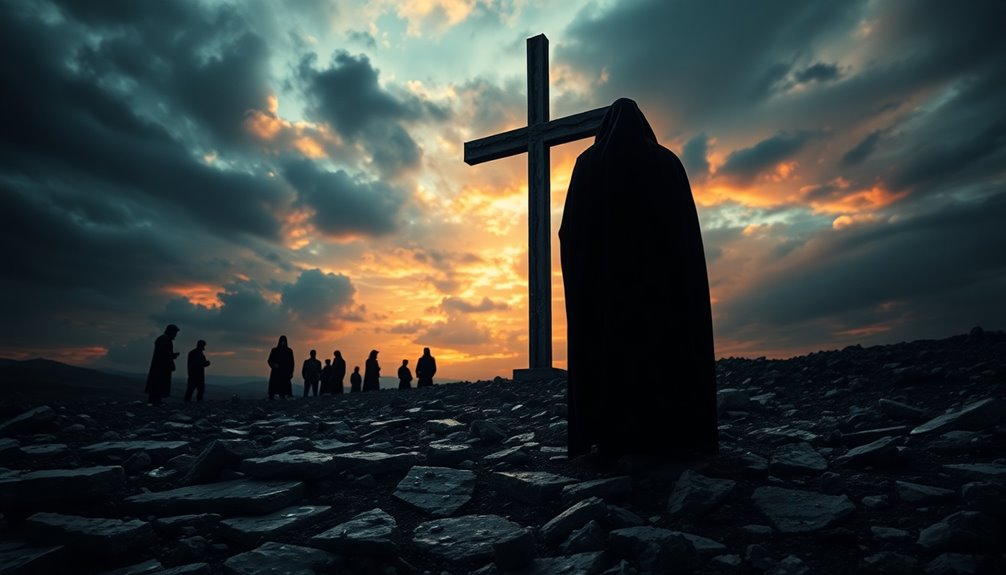You might be surprised to learn that Jesus' death involved a mix of key players. Roman authorities, especially Pontius Pilate, sentenced him, balancing local demands with maintaining order. Jewish leaders, seeing Jesus as a threat, conspired against him, presenting him to Pilate. The crowd, swayed by the moment, chose to spare Barabbas, illustrating collective complicity in the event. This intricate web of responsibility goes beyond simple blame, with historical and theological interpretations shaping our understanding. If you think this is intriguing, you're likely to uncover even deeper insights about the dynamics behind this pivotal moment.
Key Takeaways
- Roman authorities, led by Pontius Pilate, sentenced Jesus to crucifixion despite finding no fault in him.
- Jewish leaders, including chief priests, conspired against Jesus, viewing him as a threat to their authority.
- The local crowd played a crucial role by demanding Jesus' crucifixion and choosing to release Barabbas instead.
- The complex responsibility for Jesus' death involves both the Roman government and Jewish religious leaders, reflecting societal tensions.
- Misinterpretations of scripture have historically attributed collective guilt to Jewish communities, fueling harmful stereotypes and division.
Introduction
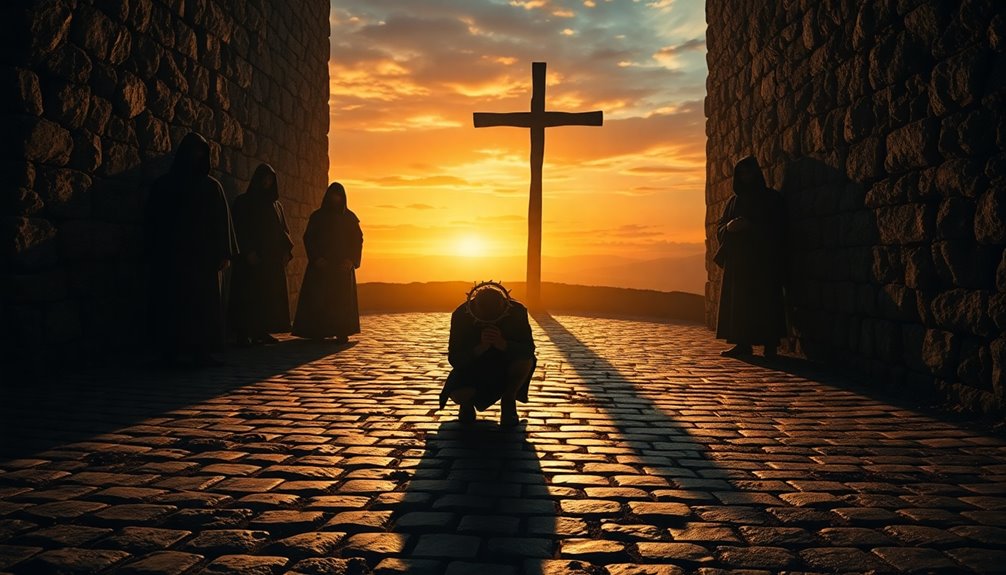
The story of Jesus' crucifixion is one of the most significant events in history, raising profound questions about responsibility and justice. As you explore this pivotal moment, it's essential to understand the roles played by various parties.
The Roman authorities, led by Pontius Pilate, ultimately sentenced Jesus to death. Despite Pilate finding no fault in him, he caved to pressure from the crowd and the Jewish leaders.
These Jewish leaders, including chief priests and elders, orchestrated the plot against Jesus, presenting him to Pilate while demanding his crucifixion. The intensity of the crowd's response can't be overlooked—shouting "Crucify him!" during the proceedings, they added to the atmosphere of fear and urgency.
While Pilate issued the final order, the physical act of crucifixion was carried out by Roman soldiers, who executed the sentence.
This complex interplay of responsibility doesn't solely rest on one group; rather, it involves the Roman authorities, the Jewish leaders, and the crowd that day. Understanding these dynamics helps clarify the historical context surrounding Jesus' death and the shared responsibility that transcends time and place.
Biblical Texts on Responsibility

When you look at the biblical texts, you'll notice varying sources of responsibility for Jesus' death.
Matthew highlights the crowd's chilling declaration, while Acts points to God's sovereign plan.
Together, these passages raise important questions about individual and collective accountability in the crucifixion.
Primary Bible References
Biblical texts illustrate the complex web of responsibility surrounding Jesus' crucifixion, inviting readers to explore various perspectives.
In Matthew 27:24-25, the crowd's chilling declaration, "His blood be on us and on our children," raises questions about collective guilt and has been interpreted as implicating the Jews in the death of Jesus. This notion has fueled debates about Jewish deicide throughout history.
Acts 2:23 adds another layer, as Peter emphasizes that Jesus was "delivered up according to the definite plan and foreknowledge of God," suggesting divine involvement alongside human actions.
Meanwhile, John 19:16 shows that Pilate ordered Jesus' crucifixion, underscoring the Roman authority's role in this execution process.
Matthew 27:22 highlights the crowd's complicity, as they chose to release Barabbas instead of Jesus, demonstrating public involvement in the decision to condemn Him.
Additionally, John 5:16-18 portrays the religious leaders' persecution of Jesus, illustrating the tensions between Him and the Jewish authorities, even though they lacked the power to execute Him.
These texts collectively present a multifaceted view of responsibility for Jesus' death.
Secondary Bible References
Exploring the concept of responsibility in Jesus' crucifixion, secondary Bible references provide further insight into the dynamics at play.
In the Gospel of John, we see the Jewish leaders conspiring to arrest Jesus, fearing he threatens their authority (John 11:47–50). This highlights a significant aspect of Jewish responsibility regarding the crucifixion of Jesus.
The crowd's declaration, "His blood be on us and on our children," from Matthew 27:24–25, has often been interpreted as a collective acceptance of guilt for his death.
However, it's essential to note that Pontius Pilate, the Roman governor, played a crucial role in this event. In Matthew 27:26, he ultimately authorizes the execution after releasing Barabbas, suggesting that while the Jews played a part, the Romans held the final authority.
Additionally, Peter's words in Acts 2:23 emphasize that the crucifixion was part of God's definite plan, indicating divine sovereignty over these events.
These secondary references clarify the intricate layers of responsibility surrounding the historical Jesus' crucifixion, illustrating that multiple parties contributed to this pivotal moment in history.
First-Century Jewish Society Dynamics
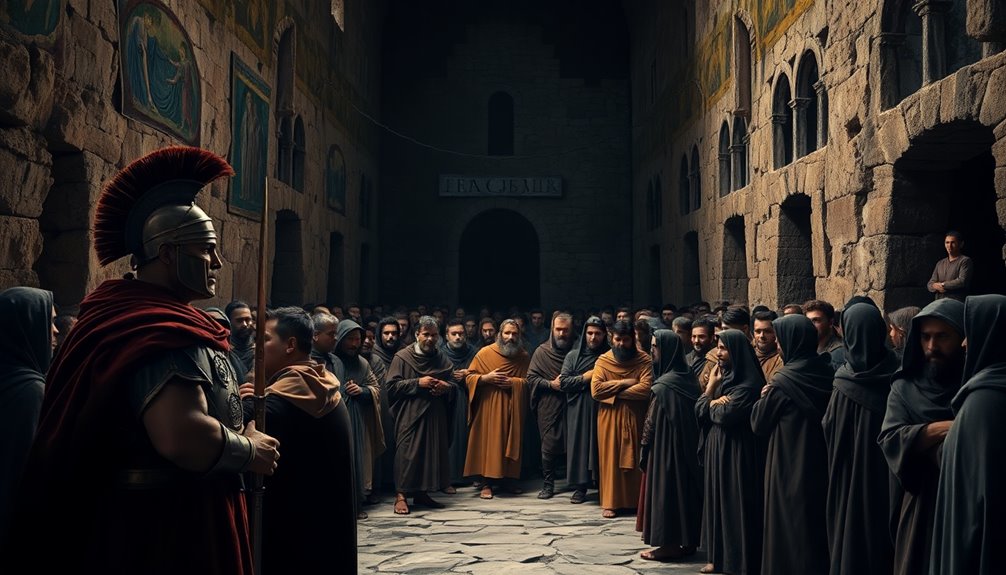
In first-century Judea, political and religious tensions shaped daily life, creating a complex society where various factions vied for influence. The Pharisees, Sadducees, and Zealots each held distinct beliefs about how to respond to Roman rule and interpreted religious law.
The Sanhedrin, the Jewish ruling council, primarily managed religious matters but lacked the authority to enforce capital punishment. This limitation forced them to collaborate with Roman authorities, especially during high-stakes situations like Jesus' trial.
The chief priests and elders of the Sanhedrin perceived Jesus as a significant threat to their religious authority and the social order. They conspired to arrest and condemn him, recognizing the potential disruption his teachings could cause within their ranks.
The Jerusalem crowd played a pivotal role during his trial, expressing their desire for his execution and choosing to release Barabbas instead. This reflected the volatile public sentiment, which could quickly shift in response to the prevailing political climate.
The harsh Roman occupation further complicated dynamics within first-century Jewish society, as leaders sought to maintain control and avoid provoking Roman wrath, ultimately leading to their facilitation of Jesus' execution.
Socio-Political Context Explored
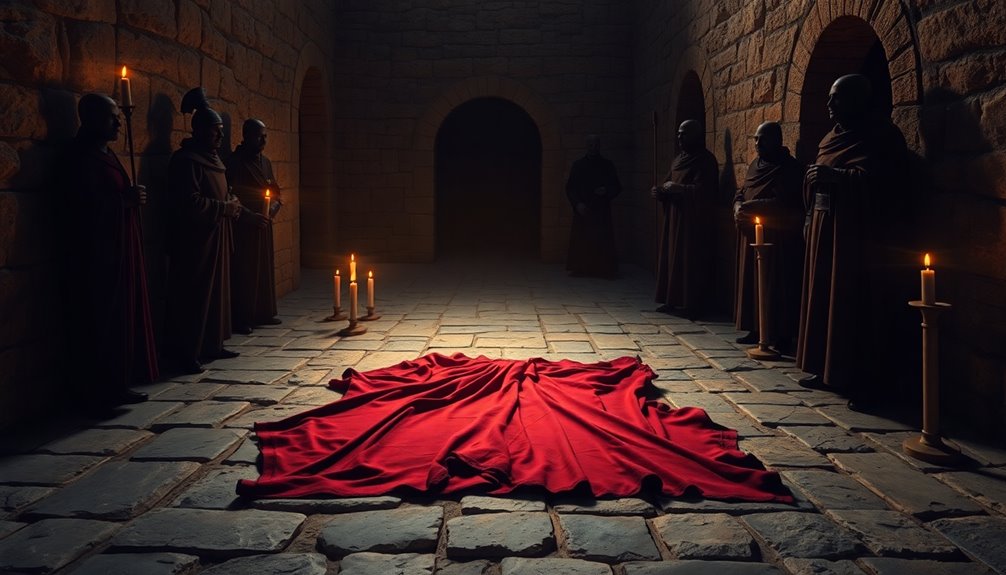
Understanding the socio-political context of first-century Judaea sheds light on the forces at play during Jesus' crucifixion. This was a time of significant unrest, with tensions running high between the Roman authorities and the Jewish population.
Pontius Pilate, the Roman governor, found himself balancing the need for order in Jerusalem with the demands of the local Jewish leaders. The high priests and elders viewed Jesus as a direct challenge to their religious authority and societal stability, prompting them to present him to Pilate and demand his execution.
The socio-political climate influenced their motivations; Jesus was perceived not just as a religious figure but potentially as a revolutionary. The crucifixion served as a means for Roman authorities to quell dissent and reinforce their control over an increasingly restless population.
The local crowd's call for Jesus' crucifixion further complicates the narrative, reflecting a mix of public sentiment shaped by fear, influence from the high priests, and the overarching pressures of Roman rule.
This interplay between the Jewish leaders and Roman governance ultimately set the stage for the tragic events that unfolded, marking a pivotal moment in history.
Misunderstandings of Jewish Roles
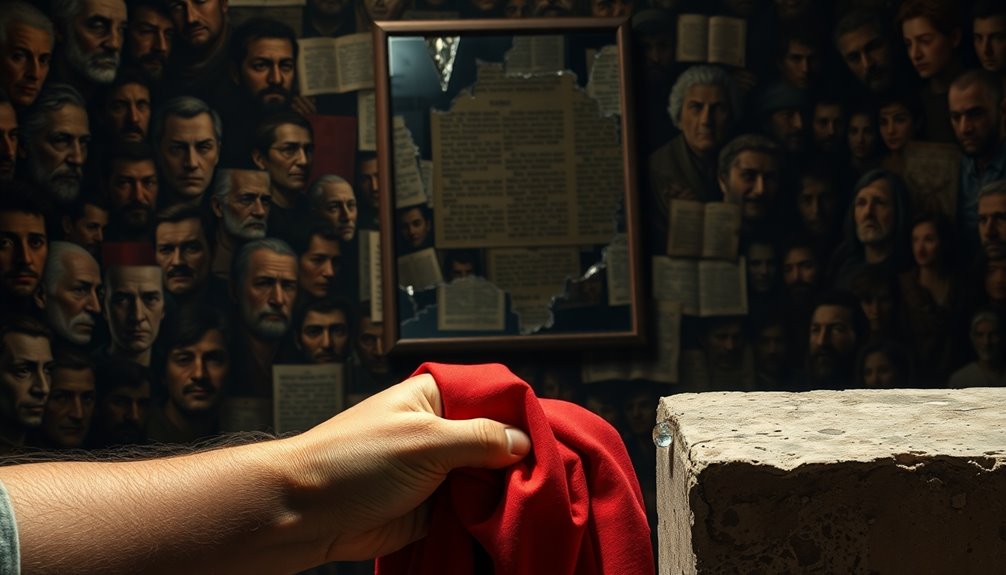
When you explore the misunderstandings surrounding Jewish roles in Jesus' death, it's crucial to recognize that historical misconceptions have fueled harmful narratives.
Many interpretations of scripture have been oversimplified, leading to a misattribution of blame to all Jews.
Debunk Historical Misconceptions
Misconceptions about Jewish roles in the death of Jesus have perpetuated harmful stereotypes and fostered division throughout history. The term "deicide" inaccurately implies collective Jewish guilt for Jesus' death, when historical interpretations clarify that only specific Jewish leaders were involved in the events leading to his crucifixion.
It's crucial to recognize that Pontius Pilate and Roman authorities were ultimately responsible for sentencing Jesus to death, as they held the execution authority under Roman law.
The Gospels show a moment of public sentiment in Jerusalem, not a universal Jewish consensus. This narrative of collective guilt unfairly blames all Jews, when in fact, such portrayals stem from early Christian writings that sought to define their identity in opposition to Judaism.
Scholars have widely challenged the notion that Jews bear multigenerational guilt for Jesus' crucifixion. In 1965, the Second Vatican Council's declaration, Nostra Aetate, explicitly repudiated this idea, reinforcing that not all Jews—past or present—are responsible for the actions of individuals during that historical period.
Understanding these nuances is vital in combating stereotypes and fostering interfaith dialogue.
Diverse Interpretations of Scripture
Diving into the diverse interpretations of scripture reveals how misunderstandings of Jewish roles in the death of Jesus have evolved over time.
The Gospel of Matthew presents a troubling passage where the crowd proclaims, "His blood be on us and our children," leading many to misinterpret this as collective Jewish guilt. Additionally, the term Ἰουδαῖοι (Ioudaioi) in the Gospel of John complicates our understanding; while some scholars argue it refers mainly to Jewish leaders, others mistakenly apply it to all Jews, thus exaggerating Jewish responsibility for Jesus' death.
Early Church Fathers, like John Chrysostom, further entrenched this narrative, painting the Jewish people as uniformly culpable. This misinterpretation was often shaped by the political climate, as early Christians sought to distance themselves from Judaism to gain acceptance in the Roman world.
Consequently, the idea of Jewish deicide emerged, fueling antisemitism and resulting in violence against Jewish communities throughout history.
It's crucial to recognize these misinterpretations and understand that the actions leading to Jesus' death were taken by specific individuals in a specific context, not the entirety of Israel.
Your awareness can help combat lingering prejudices rooted in these misunderstandings.
Community Dialogue on Responsibility

As you reflect on the complexities of Jesus' crucifixion, consider your own feelings of guilt and how they shape your understanding of responsibility.
In congregational discussions, it's vital to address accountability not just for individuals, but for communities as a whole.
How can acknowledging these layers of responsibility foster deeper connections and healing among us?
Individual Reflection on Guilt
Guilt can weigh heavily on a community, shaping its identity and interactions for generations. When you reflect on the historical texts surrounding Jesus' death, it's essential to acknowledge the complex interplay of responsibility. While specific Jewish leaders and crowds called for his crucifixion, Roman authorities ultimately carried it out.
This nuance often gets lost in the narrative, leading to a generalized perception of guilt among Jews as a people, which persists even in modern times. The phrase "His blood be on us and on our children" from Matthew 27:25 has been misinterpreted, creating a legacy of collective guilt.
However, teachings from the Council of Trent and post-Vatican II declarations, like Nostra aetate, remind you that contemporary Jews can't bear the burden of actions taken long ago. As you grapple with these ideas, consider how historical misconceptions shape your understanding of responsibility today.
It's crucial to recognize that blaming an entire group for the actions of a few isn't only unjust but perpetuates division. Embracing a more nuanced perspective allows for healing and fosters a sense of shared humanity rather than guilt.
Congregational Discussions on Accountability
Accountability in congregational discussions invites members to reflect on the complexities of historical narratives surrounding Jesus' death.
You'll find that while specific Jewish authorities were involved in plotting Jesus' death, it's crucial to understand that the broader Jewish population shouldn't bear collective responsibility. The New Testament highlights that both Jewish leaders and Roman officials, particularly Pontius Pilate, played significant roles, indicating shared responsibility rather than singular blame.
Contemporary discussions often clarify the misinterpretation of Matthew 27:25, emphasizing it refers to the immediate crowd and not all Jews throughout history. This nuanced understanding has evolved, especially post-Vatican II, where church teachings reject the idea of multigenerational guilt.
Instead, they promote reconciliation and understanding between Christian and Jewish communities. Engaging in interfaith dialogues encourages congregations to confront these historical misconceptions.
Historical Context Matters
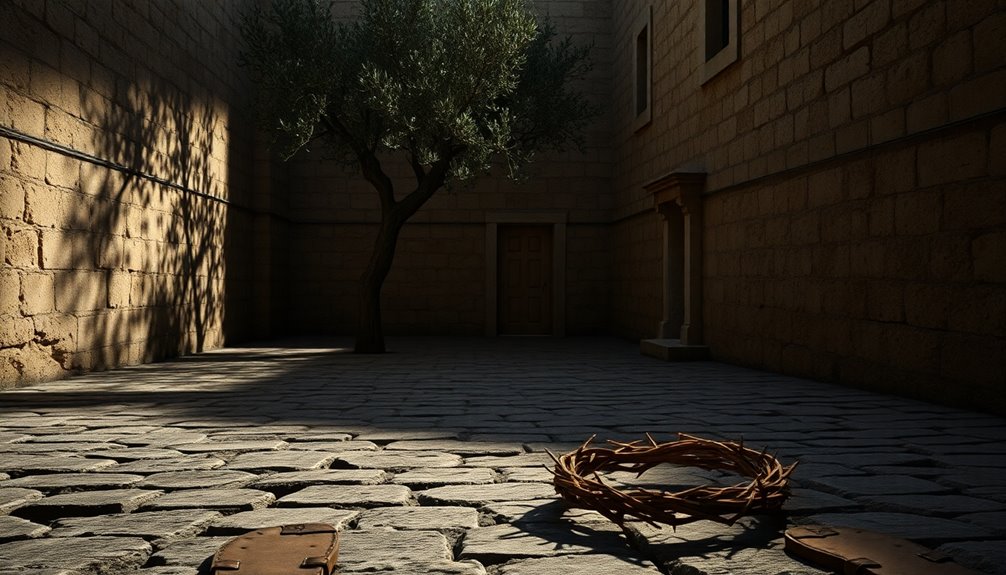
Understanding the historical context of Jesus' crucifixion is crucial for grasping the complexities surrounding his death. The event unfolded during Roman occupation in 1st-century Judaea, where the Roman authorities maintained control by executing those they deemed a threat.
Jesus' death involved key players, including Jewish leaders who conspired against him. However, they lacked the authority to carry out an execution, which led them to seek the involvement of the Romans.
Pontius Pilate, the Roman governor, played a pivotal role in the sentencing of Jesus. Despite his initial reluctance to punish Jesus, he ultimately capitulated to the pressures surrounding him. The Gospels highlight this complexity, especially when the crowd in Jerusalem called for Jesus' crucifixion, indicating a level of public complicity among those present at the trial.
Historical accounts from figures like Josephus and Tacitus affirm that Jesus was indeed crucified under Pilate, adding to the event's historicity. By examining these factors, you can better understand who truly bears responsibility for Jesus' death, recognizing the interplay between local leaders and Roman authorities within the political landscape of the time.
Additional Resources
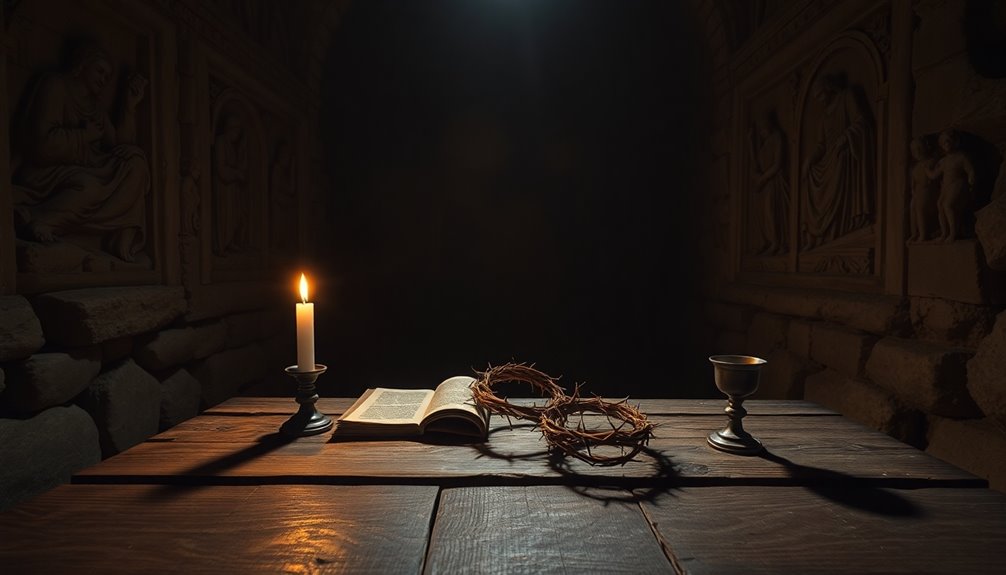
To further explore the complexities surrounding Jesus' death, a variety of additional resources can enhance your understanding.
You'll find that the New Testament provides a rich narrative, particularly in the Gospels of John, Matthew, and Luke, detailing the roles of Pontius Pilate and the Jewish leaders in the events leading to the crucifixion.
Pay attention to how Pilate, as the Roman governor, ultimately sanctioned the execution, while the Jewish leaders, including the chief priests, influenced the crowd in Jerusalem to demand Jesus' death.
Historical texts from writers like Josephus and Tacitus also shed light on the Roman context of Jesus' execution, reinforcing that it was a Roman punishment rather than solely a Jewish initiative.
Additionally, engaging with scholarly articles and commentaries can help clarify the nuanced interplay of responsibilities among the various parties involved.
Documentaries and lectures by theologians and historians can further enrich your perspective.
Frequently Asked Questions
Who Killed Jesus Historically?
When you explore the historical aspects surrounding Jesus' death, you'll find that it involved multiple parties.
The Roman authorities, particularly Pontius Pilate, played a crucial role in sentencing him to crucifixion.
Additionally, local Jewish leaders influenced the events leading up to his arrest, presenting him to Pilate with demands for his execution.
This collaboration between the Roman and Jewish authorities highlights the complex dynamics at play during that pivotal moment in history.
Who Ordered the Killing of Jesus in the Bible?
In the Bible, you'll see that the order for Jesus' execution came from Pontius Pilate, the Roman governor.
He ultimately authorized the crucifixion after being pressured by Jewish leaders and a crowd demanding Jesus' death.
Despite his initial reluctance, Pilate gave in to the public outcry.
The chief priests and elders played significant roles in instigating this demand, highlighting a complex interplay of responsibility in the events that unfolded.
Who Was Trying to Kill Jesus?
You might find that various groups were trying to kill Jesus.
Jewish religious leaders, feeling threatened by his teachings, conspired against him. They viewed him as a challenge to their authority.
Additionally, the crowd in Jerusalem played a role, demanding his crucifixion.
Ultimately, Pontius Pilate, under pressure from both the leaders and the crowd, authorized the execution despite recognizing Jesus' innocence.
Factors like fear and political pressure fueled these attempts on his life.
Who Killed Jesus According to the Quran?
According to the Quran, Jesus wasn't killed or crucified. Instead, it appeared that way to those present.
You'll find in Surah An-Nisa that Allah raised Jesus to Himself, emphasizing his role as a prophet rather than focusing on his death.
This perspective highlights the belief in God's ultimate control over events, steering clear of attributing blame for Jesus' fate to any specific group, including the Jews.

